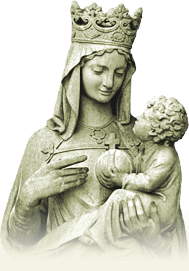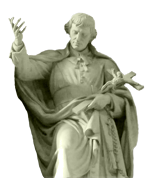Doutrina
Comunhão de pé
PERGUNTA
Nome:
Ivan
Enviada em:
27/09/2002
Prezado Prof. Orlando Fedeli.
Salve Maria !
Recebi esse documento sobre a recepção da Sagrada Comunhão sómente em pé, promulgada pela Conferencia Episcopal do Bispos dos EUA.
Peço o sua opinião, quando tiver tempo...
Pergunto: As Conferencias Episcopais podem por direito promulgar regras sobre esse tipo de questão?
Ora, os srs. Bispos devem obediencia apenas ao Santo Papa, ou tb às Conferencias Episcopais?
Com estima...
Ivan
COMMITTEE ON THE LITURGY Volume XXXVIII Jul 2002 Clarification on the Proper Posture and Sign of Veneration for Reception of Holy Communion In recent weeks, the Secretariat for the Liturgy has received several inquiries concerning both the proper posture for and the form of veneration to be made prior to receiving Holy Communion. This issue is directly addressed by the adaptation of number 160 of the General Instruction of the Roman Missal (GIRM) approved by the USCCB and confirmed by the Holy See.
That adaptation reads as follows: The norm for the reception of Holy Communion in the dioceses of the United States is standing.
Communicants should not be denied Holy Communion because they kneel. Rather, such instances should be addressed pastorally, by providing the faithful with the proper catechesis on the reasons for this norm.
When receiving Holy Communion standing, the communicant bows his or her head before the sacrament as a gesture of reverence and receives the Body of the Lord from the minister. The consecrated host may be received either on the tongue or in the hand at the discretion of each communicant. When Holy Communion is received under both kinds, the sign of reverence is also made before receiving the Precious Blood.
Secretariat for the Liturgy 3211 Fourth Street, N. E.
Washington D.C. 20017 Ph: 202-541-3060 FAX 202-541-3088 www.usccb.org Posture It should be noted that the General Instruction of the Roman Missal assigns to Conferences of Bishops the decision as to whether the faithful should stand or kneel at the time of reception of Holy Communion.(no.
43§2) The Bishops of the United States have decided that the normative posture for receiving Holy Communion should be standing. Kneeling is not a licit posture for receiving Holy Communion in the dioceses of the United States, of America unless the bishop of a particular diocese has derogated from this norm in an individual and extraordinary circumstance.
The provision which follows this section is provided for those extraordinary circumstances when a communicant acts in contradiction to the decision of the bishops. Under no circumstances may a person be denied Holy Communion merely because he or she has refused to, stand to receive Holy Communion. Rather, in such instances, the priest 81 is obliged to provide additional catechesis so that the communicant might better understand the reason for the Bishops' decision to choose standing as the normative posture for receiving Holy Communion in the dioceses of the United States of America.
Sign of Veneration In a similar way, the General Instruction (no. 160§2) assigns to Conferences of Bishops the responsibility to determine "an appropriate gesture of reverence" to be made before receiving the Blessed Sacrament. Thus, in the dioceses of the United States of America, the communicant is directed by this particular law to "bow his or her head before the sacrament as a gesture of reverence and receive the Body of the Lord from the minister."
Uniformity in Posture The General Instruction of the Roman Missal emphasizes that in matters of gesture and posture "greater attention needs to be paid to what is laid down by liturgical law and by the traditional practice of the Roman Rite, for the sake of the common spiritual good of the people of God rather than to personal inclination or arbitrary choice" (GIRM, no. 42).
Throughout their consideration of GIRM numbers 43 and 160, the Bishops repeatedly recalled the need for uniformity in all prescribed postures and gestures.
Such uniformity serves as a "sign of the unity of the members of the Christian community gathered for the sacred Liturgy" and it "both expresses and fosters the spiritual attitude of those assisting" (GIRM, no. 42).
Likewise, a lack of uniformity can serve as a sign of disunity or even a sense of individualism. A particular example of this disunity has been cited by many of the Bishops in regard to a diversity of postures during the Eucharistic Prayer, "the center and summit of the entire celebration" (GIRM, no. 78).
Thus, the variation from kneeling as the uniform posture during the Eucharistic Prayer is permitted only "on occasion" and when the circumstances found by GIRM (no. 43) are clearly present.
In describing the indispensable role of the gathered faithful at Mass, the General Instruction of the Roman Missal presents them as "a holy people, a chosen people, a royal priesthood" who "give thanks to God and offer the Victim not only through the hands of the priest but also together with him and learn to offer themselves" (GIRM" no. 95). Two responsibilities grow from this noble identity: "fostering of a deep sense of reverence for God as well as developing charity towards their brothers and sisters who share with them in the celebration" (GIRM, no. 95). Such a sense of reverence for God and charity for the other members of the liturgical assembly is concretely manifested by a unity in word, song, posture and gesture. Thus, this section concludes that the faithful are to shun any appearance of individualism or division, keeping before their eyes that they have the one Father in heaven and therefore are all brothers and sisters to each other" (GIRM, no. 95).
The Diocesan Bishop and the Missale Romanum, editio typica tertia Among the most significant changes in the third edition of the Missale Romanum is the addition of an eighth chapter to the Institutio Generalis Missalis Romani (GIRM) under the title, "Adaptations which are the Competence of Bishops and Conferences of Bishops."
The revised Institutio Generalis describes the Diocesan Bishop as "the high priest of his flock ...
from whom, in some sense, the life in Christ of its faithful is derived and is dependent, must foster, govern and watch over the liturgical life in his diocese" (GIRM, no. 367; see Sacrosanctum Concilium, no. 41). The Institutio Generalis, while noting that it is "his primary task is to nourish the priests, the deacons and the faithful with the spirit of the sacred Liturgy," (GIRM, no. 367) describes four ways in which the diocesan Bishop is called upon to exercise this governance in the implementation of the revised Missale Romanum: 82
RESPOSTA
Muito prezado Dr. Ivan, salve Maria!
O senhor tem muita razão ao dizer que cada Bispo deve obediência apenas ao Papa. As Conferências Episcopais são órgãos puramente humanos e "democráticos", que não foram instituídos por Cristo, na Igreja. Cada Bispo é senhor feudal de sua Diocese devendo contas apenas ao Papa. Nenhuma Conferência Episcopal tem direito de legislar sobre as Dioceses.
Esse documento da Conferência dos Bispos dos Estados Unidos é tipicamente "democrático". Sob o pretexto de manter a unidade dos fiéis, e os Bispos americanos introduzem um costume contrário ao que sempre foi praticado na igreja: comungar de joelhos. Eles é que causam a desunião, mudando o costume milenar, e depois, tiranicamente -- eles querem agir democraticamente -- impõem um costume novo à força.
Uma vez, quando se introduziu -- "democraticamente" --aqui, no Brasil, o costume de comungar de pé, eu estava na Missa na Igreja de São Francisco, quando, na hora da comunhão o sacerdote impôs, sempre democraticamente, que todos comungassem de pé. Respeitando a autoridade dele, e sem protestar, obedeci, e recebi a comunhão de pé.
Depois da Missa fui falar com o sacerdote. Cumprimentei-o educadamente e pedi que, se possível, ele me explicasse por que era melhor comungar de pé.
Ele me respondeu que receber a comunhão de joelhos era farisaísmo. Disse-lhe eu então que, no Evangelho, era o fariseu que rezava de pé.
Como ele nada podia refutar o meu argumento, ele saiu gritando e batendo as portas. Sempre democraticamente e de acordo com o Vaticano II, que pretendeu fazer a promoção do laicato.
Se assim esses padres democráticos e modernos tratam os fiéis que ousam argumentar educadamente, indicando possuírem um espírito de rebeldia e de capricho, como aceitariam eles um gesto de submissão humilde diante da Hóstia?
Tanto mais que muitos desses padres não crêem na presença real de Cristo na Sagrada Hóstia. Eles crêem no Homem. No Homem abstrato, porque quanto ao homem concreto, que lhes beija a mão pedindo a bênção, eles o repelem e o vêem com desagrado.
Contradições desses padres de uma Nova Igreja, que exigem para si o máximo de respeito, impondo até os seus caprichos, recusam que se preste qualquer gesto de respeito para com a Sagrada Hóstia. Teria eu muitos casos que comprovam o que digo, mas não é aqui e agora a ocasião de contá-los. A lista é longa, o tempo é curto e a maldade é imensa. Tempora mala sunt...
In Corde Jesu, semper,
Orlando Fedeli
O senhor tem muita razão ao dizer que cada Bispo deve obediência apenas ao Papa. As Conferências Episcopais são órgãos puramente humanos e "democráticos", que não foram instituídos por Cristo, na Igreja. Cada Bispo é senhor feudal de sua Diocese devendo contas apenas ao Papa. Nenhuma Conferência Episcopal tem direito de legislar sobre as Dioceses.
Esse documento da Conferência dos Bispos dos Estados Unidos é tipicamente "democrático". Sob o pretexto de manter a unidade dos fiéis, e os Bispos americanos introduzem um costume contrário ao que sempre foi praticado na igreja: comungar de joelhos. Eles é que causam a desunião, mudando o costume milenar, e depois, tiranicamente -- eles querem agir democraticamente -- impõem um costume novo à força.
Uma vez, quando se introduziu -- "democraticamente" --aqui, no Brasil, o costume de comungar de pé, eu estava na Missa na Igreja de São Francisco, quando, na hora da comunhão o sacerdote impôs, sempre democraticamente, que todos comungassem de pé. Respeitando a autoridade dele, e sem protestar, obedeci, e recebi a comunhão de pé.
Depois da Missa fui falar com o sacerdote. Cumprimentei-o educadamente e pedi que, se possível, ele me explicasse por que era melhor comungar de pé.
Ele me respondeu que receber a comunhão de joelhos era farisaísmo. Disse-lhe eu então que, no Evangelho, era o fariseu que rezava de pé.
Como ele nada podia refutar o meu argumento, ele saiu gritando e batendo as portas. Sempre democraticamente e de acordo com o Vaticano II, que pretendeu fazer a promoção do laicato.
Se assim esses padres democráticos e modernos tratam os fiéis que ousam argumentar educadamente, indicando possuírem um espírito de rebeldia e de capricho, como aceitariam eles um gesto de submissão humilde diante da Hóstia?
Tanto mais que muitos desses padres não crêem na presença real de Cristo na Sagrada Hóstia. Eles crêem no Homem. No Homem abstrato, porque quanto ao homem concreto, que lhes beija a mão pedindo a bênção, eles o repelem e o vêem com desagrado.
Contradições desses padres de uma Nova Igreja, que exigem para si o máximo de respeito, impondo até os seus caprichos, recusam que se preste qualquer gesto de respeito para com a Sagrada Hóstia. Teria eu muitos casos que comprovam o que digo, mas não é aqui e agora a ocasião de contá-los. A lista é longa, o tempo é curto e a maldade é imensa. Tempora mala sunt...
In Corde Jesu, semper,
Orlando Fedeli








